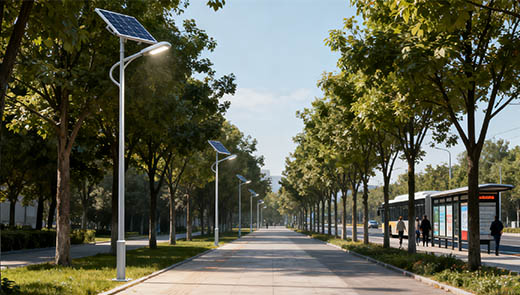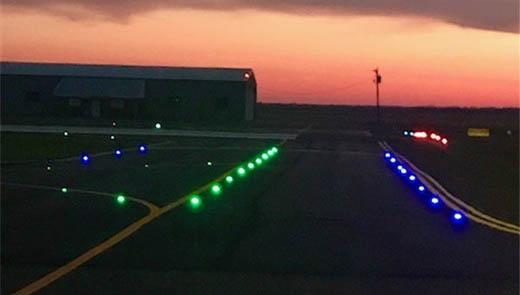Several Factors Affecting the Performance of Solar Road Studs
With the increasing frequency of nighttime traffic accidents, solar road studs, as a new type of traffic auxiliary equipment, are gradually becoming a core component of road safety construction. Not only can they effectively improve road visibility at night and in adverse weather conditions, but they also align perfectly with the current trends of promoting renewable energy and developing smart cities due to their solar-powered characteristics. Understanding the key factors affecting the performance of solar road studs is a prerequisite for selecting durable and efficient products, as well as a crucial step in reducing maintenance costs and ensuring long-term road safety. This article will start with a basic understanding of solar road studs, delve into the factors influencing their performance, and provide practical purchasing recommendations.
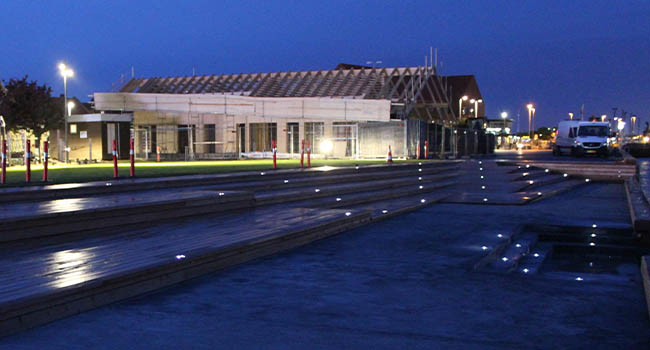
Understanding solar road studs
What are solar road studs?
Solar road studs, also known as solar road markers or solar cat's eyes, are traffic guidance devices embedded in the road surface. They achieve the function of “storing energy during the day and emitting light at night” through built-in components. The common core components are shown in the table below:
|
Core Component |
Main Function |
|
Solar Panel |
Absorbs sunlight and converts it into electrical energy |
|
LED Light |
Provides illumination at night or in low-light conditions for road guidance |
|
Rechargeable Battery |
Stores electricity generated during the day to power the LED light |
|
Protective Housing |
Protects internal electronic components from vehicle pressure and environment |
How solar road studs work
The operation of solar road studs is clear and efficient, consisting of four main steps: During the day, solar panels actively absorb light energy; the panels then convert the light energy into electrical energy and transmit it to rechargeable batteries; the batteries store the electrical energy until the ambient light weakens; when the light intensity falls below the set threshold, the device automatically activates the LED lights to provide guidance for road users. This “light-controlled automatic switching” mode requires no manual intervention, adapts to varying light conditions, and ensures continuous functionality during twilight, dawn, and night time.
Functions of solar road studs
Enhancing road visibility and safety
During nighttime or adverse weather conditions, traditional road markings may become blurred due to insufficient light or even covered by standing water, making it difficult for drivers to accurately determine road boundaries. Solar road studs emit continuous light via LED lights, clearly outlining the road's contours. They can be clearly identified from as far as 50 meters away, helping drivers anticipate road conditions 1-2 seconds in advance. This reduces accidents caused by “inability to see the road,” such as rear-end collisions or lane deviations. According to traffic department statistics, sections of road equipped with solar road studs see a reduction in nighttime accident rates of over 35%.
Lane guidance
In scenarios such as highways and multi-lane urban roads, solar road studs can serve as “dynamic lane dividers.” Especially on suburban highway sections without streetlights, their stable illumination provides drivers with continuous reference for lane boundaries. For long-haul truck drivers and other groups prone to fatigue, clear luminous boundaries can effectively prevent lane drift or sudden lane changes caused by inattention, thereby reducing the risk of side collisions. Data shows that after installing solar road studs on highways, lane departure-related accidents decreased by 40%.
Warning and alert systems
Some solar-powered road studs with programmable functions can use different flashing patterns to provide precise warnings for specific hazardous areas. For example, on sharp curves, the studs can be set to “high-frequency flashing” to prompt drivers to slow down in advance; in road construction zones, multiple studs can be linked to form a “dynamic warning strip” to guide vehicles to slow down and avoid the area; on both sides of crosswalks near schools and residential areas, studs can maintain a “constant-on + low-frequency flashing” mode, illuminating pedestrian paths while reminding drivers to yield. Such applications can reduce accident rates in hazardous areas by over 50%.
Pedestrian safety
Solar-powered road studs are not solely designed for motor vehicle traffic. In areas such as crosswalks, park paths, and campus roads, they can illuminate pedestrian pathways using low-brightness, long-lasting lighting modes. Especially in older neighborhoods, suburban towns, and other areas without streetlight coverage, luminous road studs make pedestrians more visible to drivers, preventing “sudden appearance” accidents. They also provide safe guidance for residents walking or cycling at night, enhancing the safety and comfort of the slow-moving transportation system.
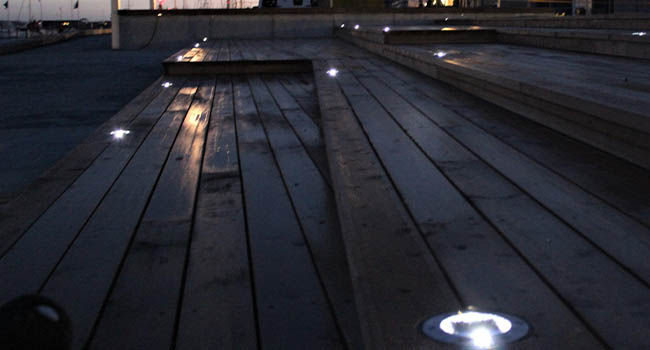
Environmentally friendly and energy-saving
Compared to traditional electrically powered road studs, solar-powered road studs do not require underground cable installation, reducing excavation costs during road construction and eliminating safety hazards such as cable aging and electrical leaks. Long-term use can save transportation departments significant electricity and maintenance costs, aligning with infrastructure development requirements under the dual carbon goals.
Factors affecting the performance of solar road studs
Compressive capacity
After being embedded in the road surface, solar road studs must withstand long-term vehicle crushing. If the compressive strength is insufficient, internal components such as batteries and circuits may be damaged, and the outer shell may crack, leading to equipment failure. The compressive strength typically ranges from 10 to 25 tons, suitable for urban roads and highways. To balance component protection and resistance to vehicle crushing, high-quality products often use ABS+PC alloy, which combines flexibility and hardness to absorb impacts. Alternatively, die-cast aluminum, which offers high strength and heat resistance, is suitable for high-temperature regions and high-traffic sections, and is used to manufacture the outer casing of solar road studs.
Sealing performance
Rainwater, standing water, and de-icing agents in road environments can easily penetrate the interior of road studs. Poor sealing can cause electronic components to short circuit, leading to short-term issues such as LED light flickering and battery failure to store energy, which affects nighttime guidance. Over the long term, it can corrode circuits, cause metal components to rust, and ultimately render the road studs unusable, increasing maintenance costs and construction frequency. The key to assessing sealing performance is the IP waterproof rating. IP68 is the industry's premium standard, meaning it is completely dust proof and can be submerged in 1.5 meters of water for 30 minutes without water ingress. In regions with heavy rainfall, snowfall, or coastal humidity, selecting products with this rating or higher can extend the lifespan of road studs to over five years.
Brightness
Brightness directly affects the driver's recognition distance and clarity. Solar-powered road studs emit light actively, with a brightness of 200-500 cd, providing a nighttime recognition distance of 150-300 meters, far exceeding that of ordinary reflective road studs. However, brightness is not always better; it must be matched to the scenario: highways require 250-500 cd to ensure sufficient reaction time for drivers at high speeds; secondary urban roads and residential area roads require 150-250 cd to avoid excessive brightness causing glare that affects oncoming vehicles; sidewalks and park paths require 50-150 cd to balance pedestrian visibility and energy efficiency.
Battery life
The battery stores electrical energy, and its lifespan is equivalent to the effective service life of the road stud. Frequent replacements increase costs and disrupt road traffic. High-quality batteries must have a long cycle life and wide temperature adaptability. Lithium-ion batteries have a cycle life of 1,000–2,000 cycles, can be used for 3–5 years, and operate normally at temperatures ranging from -30°C to 70°C, with a discharge rate exceeding 70% at low temperatures. Lead-acid batteries have a cycle life of only 300-500 cycles, lasting 1-2 years, with performance significantly declining below 0°C, often resulting in “incomplete charging or failure to illuminate” during winter; nickel-metal hydride batteries offer moderate cost-effectiveness but experience capacity degradation.
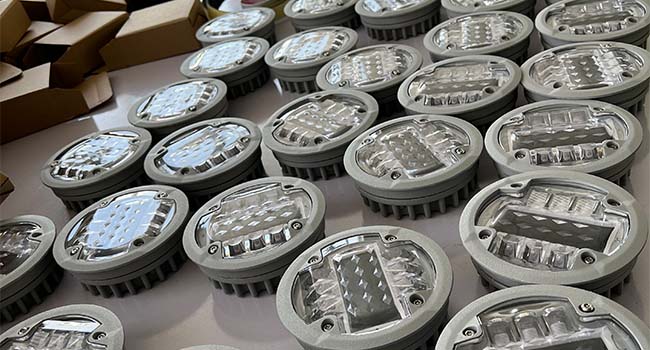
Solar panel
The solar panel is the “energy source” of the solar road stud, and its quality directly impacts light energy conversion efficiency. Low conversion efficiency can lead to insufficient energy storage, resulting in inadequate LED brightness or inability to sustain illumination at night. High-quality solar panels require high conversion efficiency, high hardness and wear resistance, and impact resistance. Wear significantly affects performance; without wear, they can store energy normally and emit light for 10-12 hours at night, but with severe wear, conversion efficiency drops below 10%, rendering the road stud completely ineffective.
Practical tips for selecting high-performance solar road studs
Match compression strength
First, clarify the installation scenario of the road studs — if used on urban main roads or highways, select products with compression strength ≥20 tons to ensure they can withstand daily vehicle crushing ; if used on residential roads or sidewalks, select products with 10-15 tons compression strength to meet basic protective requirements while reducing procurement costs. Additionally, inspect the shell material on-site and prioritize die-cast aluminum or ABS+PC alloy shells, avoiding ordinary plastic shells, which are prone to deformation and cracking.
Verify sealing and waterproof performance
Sealing performance directly determines the service life of road studs, so it is essential to require products to meet an IP68 or higher sealing rating and request suppliers to provide corresponding certification documents. Additionally, carefully inspect the seams of the road stud housing: high-quality products should have uniform, smooth seams with no visible gaps. Some premium products may also apply additional waterproof sealant (such as silicone sealant) at the seams to enhance sealing performance.
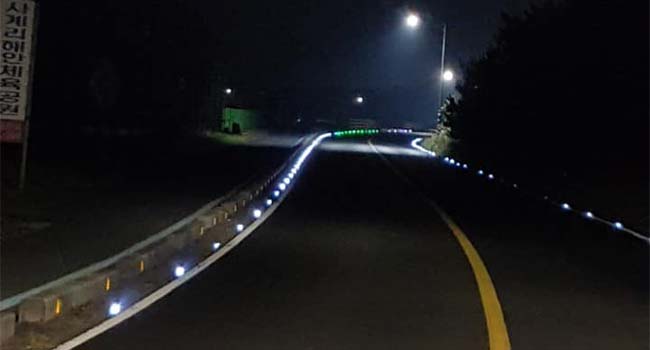
Brightness and battery core parameters
Regarding brightness, reject vague descriptions such as “very bright” or “sufficient brightness.” Require suppliers to provide specific “luminous intensity values”—highways require 250-500 cd, urban secondary roads require 150-250 cd, and sidewalks require 50-150 cd. Confirm whether the values are suitable based on the actual application scenario.
For batteries, prioritize lithium-ion batteries and clearly inquire about two key parameters: cycle life and operating temperature range. If the local winter is cold, prioritize confirming the battery's “low-temperature charging performance” to avoid issues with the battery failing to store energy normally due to low temperatures in winter.
Inspecting the quality of solar panels
When inspecting the quality of solar panels, first examine the materials. High-quality products typically use a composite structure consisting of “tempered glass + EVA + back sheet.” You can perform a simple “key scratch test” to assess surface hardness. If no noticeable scratches appear after scratching, it indicates that the hardness meets standards.
Second, select the type based on the local sunlight conditions. In regions with insufficient sunlight, such as rainy or foggy cities, prioritize monocrystalline silicon panels with a conversion efficiency of 18%-22%. In areas with ample sunlight, polycrystalline silicon panels with a conversion efficiency of 15%-18% can be selected to ensure efficient energy storage under different climatic conditions.
Finally, check the fit. Ensure the panels are securely attached to the housing with no loose parts to prevent water from seeping in and damaging internal circuits. Also, carefully inspect the edges of the panels; if there are any defects such as damage or cracks, such products should be immediately excluded.
The performance of solar road studs is not determined by a single factor but is the result of the combined influence of key factors: “compressive strength, sealing performance, brightness, battery lifespan, circuit design, and solar panel quality.” For transportation departments and engineering firms, selecting high-performance solar road studs may result in slightly higher procurement costs in the short term, but in the long term, they can significantly reduce maintenance costs—high-quality products have a service life of over five years, which is two to three times longer than inferior products, while also significantly improving road safety and reducing the incidence of nighttime accidents.


